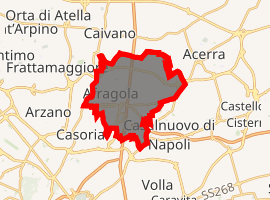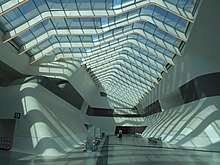Afragola
Afragola (Italian pronunciation: [afraˈɡoːla]) is a city and comune in the Metropolitan City of Naples, in Italy. It is one of the 100 largest Italian cities (the ones that have a population of more than 63,000 inhabitants).
Afragola | |
|---|---|
| Comune di Afragola | |
 Afragola City Hall | |
 Coat of arms | |
Location of Afragola 
| |
 Afragola Location of Afragola in Italy  Afragola Afragola (Campania) | |
| Coordinates: 40°55′N 14°19′E | |
| Country | Italy |
| Region | Campania |
| Metropolitan city | Naples (NA) |
| Government | |
| • Mayor | Claudio Grillo |
| Area | |
| • Total | 17.9 km2 (6.9 sq mi) |
| Elevation | 43 m (141 ft) |
| Population (28 February 2017)[2] | |
| • Total | 64,470 |
| • Density | 3,600/km2 (9,300/sq mi) |
| Demonym(s) | Afragolesi |
| Time zone | UTC+1 (CET) |
| • Summer (DST) | UTC+2 (CEST) |
| Postal code | 80021 |
| Dialing code | 081 |
| Patron saint | St. Anthony of Padua |
| Saint day | June 13 |
| Website | Official website |
The communal territory, measuring 18 square kilometres (7 square miles), borders the municipalities of Acerra, Casalnuovo di Napoli, Caivano, Cardito and Casoria, forming a single metropolitan area of around 100,000 inhabitants. The comune of Afragola is one of the most densely populated of the country.
History
The area of modern Afragola was already settled in ancient times by the Samnites. Older remains, belonging to an early Bronze Age settlement buried by a Vesuvius eruption in the 19th century BC, were found in 2005.
The town was founded only in the Middle Ages: according to a tradition now recognized as false,[3] in 1140 by Roger II of Sicily, who assigned the land to its veterans. It is more likely that the city stemmed from the merger of several villages and churches already existing here. The territory was originally held by the archbishops of Naples, but from 1576 it was directly subjected, as an autonomous community, to the Kings of Naples.
Main sights
- Baroque sanctuary-basilica of St. Anthony's sanctuary-basilica. It was begun in 1633 and has a nave with two aisles, internally decorated with marbles. The bell tower was constructed from 1590.
- The castle, documented from 1495, was likely built from around 1420. According to the tradition, it was a residence of queen Joanna II of Naples. It currently houses a childhood school.
- Santa Maria d'Ajello : Church founded in 1190. It houses works by Giovan Angelo Criscuolo, Alessandro Viola (1695) and Angelo Mozzillo.
- San Marco in Sylvis Church built around 1179. On its external wall is a slab on which, according to the legend, once sat both St. Mark and San Gennaro.
- San Marco all'Olmo: Church built in 1615.
- Palazzo Migliore (17th century)
- San Giorgio Martire: Parish church built in 1695-1702
Transport

Afragola has a recently built high-speed railway station designed by the architect Zaha Hadid and opened in 2017. This station is only used by high-speed trains on the Rome–Naples high-speed line, that link Afragola to many more italian cities, like Bologna, Milan, Florence, Turin, ecc. Because of the recent opening of the station and other types of issues, there are not so many shops and restaurants in there, as everyone should expect from a train station. In Afragola there is also a bus transport system, managed by CTP (Consorzio Trasporto Pubblico => Public Transport Consortium), even though it doesn't work very well, considering that almost no bus is seen in town.
Criminality and social issues
Afragola is the seat of one of the largest camorra clans of the area, that led by Anna Mazza. In 1999 and 2005, the communal council was disbanded by rule of the President of Italian Republic due to mafia allegiance of some of its members.[4]
Along with most of the nearby communes, Afragola also suffers from high pollution rates, as well as a high unemployment rate; unreported employment is also widespread.[5]
Places to visit
Afragola is mainly known for one of the most famous and nationwide known ice-cream shops, "La Scimmietta". Born in the last century, "La scimmietta" is located in different places in the region: not only in "Via Giovanni Amendola" (Giovanni Amendola Street) and in the shopping centre known as Ipercoop, both in Afragola, but also in the "Centro Campania", which is the most famous shopping centre in the whole region (These are just a few places in which you can find these notorious ice-cream shops). La scimmietta is known by people from the whole country, because it is also the official sponsor of the San Paolo Stadium in Fuorigrotta, the latter being a famous neapolitan district.
Apart from La Scimmietta, Afragola has a multiplex cinema and a theatre. The multiplex is located in the Ipercoop shopping center, which is very far from the city centre, but easily reachable by car. Thousands of people from the whole region go to see movies there and can have dinner in one of the numerous restaurants in the shopping mall. The theatre is called "Teatro Gelsomino" and it was originally a monoplex cinema, which was turned into a theater in 2010, because of the strong competition with the multiplex, much bigger and less expensive than the theatre.
References
- "Superficie di Comuni Province e Regioni italiane al 9 ottobre 2011". Istat. Retrieved March 16, 2019.
- "Popolazione Residente al 1° Gennaio 2018". Istat. Retrieved March 16, 2019.
- Capasso, Gaetano. Afragola, Dieci secoli di storia comunale. Aspetti e Problemi. Athena Mediterranea.
- "le decisioni del Tar". La Repubblica. Retrieved June 11, 2013.
- "I cantieri della vergogna". Archivio.rassegna.it. Retrieved June 11, 2013.
External links
| Wikivoyage has a travel guide for Afragola. |
- Official website (in Italian)
- . New International Encyclopedia. 1905.
